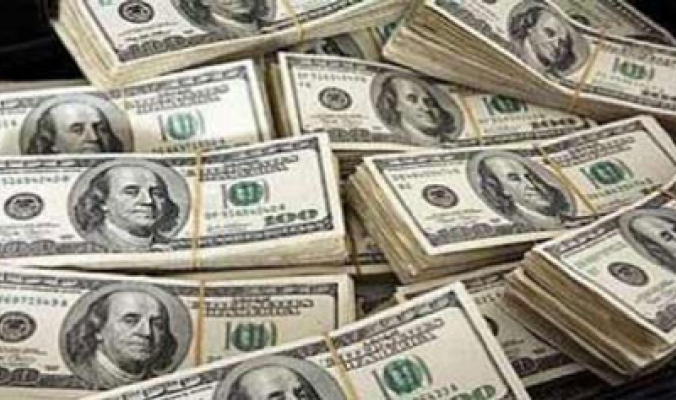
US debt rises to a record $ 22 trillion
The US debt has become larger than the US economy itself, reaching $ 22 trillion under President Donald Trump, a record size that no longer drives even Republicans.
When Trump took office in the White House, the total chronic deficit and debt benefits were mainly due to a deficit of $ 19.950 trillion, equivalent to the United States' gross domestic product, for the first time since World War II.
Tax exemptions for the Trump government, specifically for companies, as well as inflation of expenditures, especially on armaments, have increased this burden.
"At first I want to regulate the army before it gets caught up with $ 22 trillion in debt," he said.
His administration continues to reassure that tax cuts, expected to increase the budget deficit by $ 1,500 billion over 10 years, will self-finance by stimulating growth and thus returns. The budget deficit rose 17 percent to $ 779 billion last year, its worst overall value since 2012. According to the Congressional Budget Office, the deficit will rise further this year to $ 900 billion.
After four years of government budget surpluses under Bill Clinton, George W. Bush's war on Iraq plunged federal funds into deficits. In the era of Barack Obama, the financial crisis in 2008 brought strong support from the state. Accounts have deteriorated dramatically, leading to the emergence of the Tea Party, a political movement that helped bring Donald Trump to power.
With the recovery of the economy and Obama's congressional debate on cutting public spending, recent years of Obama's rule have seen a fall in deficits. At the end of Obama's term and the arrival of Trump to power, no one was shocked by the deterioration of the situation, including Republicans who had previously been tough on the use of public funds.
Federal Reserve Chairman Jerome Powell says from time to time: "It's already known that the US government's budget is on an unstable path and must be addressed," he said, avoiding himself from interfering in politics.
But lessons are required when the cost of debt service itself is inflated by the Fed raising interest rates. Trump did not hesitate to inform the central bank of his position, describing him as a "madman" and a "problem on the economy" when he raised interest. For example, the high cost of debt service alone cost the US government an additional $ 13 billion in December.
Apart from the sovereign debt that remains, thanks to the dollar, a safe investment in the eyes of the world as well as American households, some corporate and consumer debt is of greater concern.
US corporate loans have almost doubled in almost a decade, fueled by monetary policy adopted by the Reserve Council after the 2008 crisis.
The corporate debt amounted to $ 9 trillion, and according to the head of the central bank, «a risk to the macro economy».
الدَيْن الأميركي يرتفع إلى مستوى قياسي عند 22 تريليون دولار
بات الدين الاميركي أضخم من اقتصاد الولايات المتحدة نفسه، إذ وصل إلى 22 تريليون دولار في عهد الرئيس دونالد ترامب، وهو حجم قياسي لم يعد يحرّك حتّى الجمهوريين.
عندما تولى ترامب مهامه في البيت الأبيض، كان مجموع العجز المزمن وفوائد الدين يبلغ أساساً الدين الناجم عن عجز 19.950 تريليون دولار، أي ما يعادل إجمالي الناتج المحلي للولايات المتحدة، لأوّل مرة منذ الحرب العالمية الثانية.
وزادت الإعفاءات الضريبية لحكومة ترامب وتحديداً للشركات، إضافة إلى تضخم النفقات خصوصاً على التسلح، من هذا العبء.
وقال الرئيس الأميركي أخيراً: «أريد في البداية تنظيم أمور الجيش قبل أن أنشغل بـ22 تريليون دولار من الديون».
وتواصل إدارته الطمأنة الى أن تخفيضات الضرائب التي يتوقع أن تفاقم عجز الموازنة بـ1500 بليون دولار خلال 10 سنوات، ستموّل نفسها بنفسها عبر تنشيط النمو وبالتالي العائدات. وارتفع عجز الموازنة 17 في المئة إلى 779 بليون دولار العام الماضي، في أسوأ قيمة اجمالية منذ العام 2012. وبحسب مكتب الموازنة في الكونغرس، فإن العجز سيتصاعد أكثر هذا العام ليصل إلى 900 بليون دولار.
وبعد أربع سنوات من الفائض في الموازنة الحكومية في عهد بيل كلينتون، أغرقت حرب جورج بوش الابن على العراق الأموال الاتحادية في العجز. وفي عهد باراك أوباما، استدعت الأزمة المالية عام 2008 دعماً قوياً من الدولة. وتدهورت الحسابات بشكل كبير، مؤديةً إلى ظهور «حزب الشاي»، وهو حركة سياسية ساعدت في إيصال دونالد ترامب إلى السلطة.
ومع انتعاش الاقتصاد ونزاع أوباما في الكونغرس حول خفض الإنفاق العام، شهدت الأعوام الأخيرة لحكم أوباما انخفاضاً في العجز. وعند نهاية عهد أوباما ووصول ترامب إلى السلطة، لم يصدم تدهور الوضع أحدا بما في ذلك الجمهوريين الذين كانوا في السابق صارمين بشأن استخدام الأموال العامة.
ويقول رئيس مجلس الاحتياط الفيديرالي جيروم باول من وقتٍ إلى آخر: «بات معروفاً أن موازنة الحكومة الأميركية هي على مسار غير مستقر ويجب معالجتها»، نائيا بنفسه عن التدخل في السياسة.
لكن إعطاء الدروس أمر مطلوب عندما تكون كلفة خدمة الدين نفسها تضخمت نتيجة رفع مجلس الاحتياط معدلات الفائدة. ولم يتردد ترامب في إعلام البنك المركزي بموقفه منه، واصفاً إياه بـ«المجنون» وبأنه «مشكلة على الاقتصاد» لدى رفعه للفوائد. وعلى سبيل المثال، فإن ارتفاع كلفة خدمة الدين وحدها كلفت الحكومة الأميركية 13 بليون دولار إضافية في كانون الأول الماضي.
وإلى جانب الدين السيادي الذي يبقى، بفضل الدولار، استثماراً آمناً في نظر العالم كما الأسر الأميركية، فإن بعض ديون الشركات والمستهلكين تثير قلقا أكبر.
وارتفعت قروض الشركات الأميركية منذ حوالى عشر سنوات بمقدار الضعف تقريبا، تغذيها السياسة النقدية التي اعتمدها مجلس الاحتياط بعد أزمة 2008.
وبلغت ديون الشركات 9 تريليون دولار، وتشكّل وفق رئيس البنك المركزي، «خطراً على الاقتصاد الكليّ».
Comments
Post a Comment